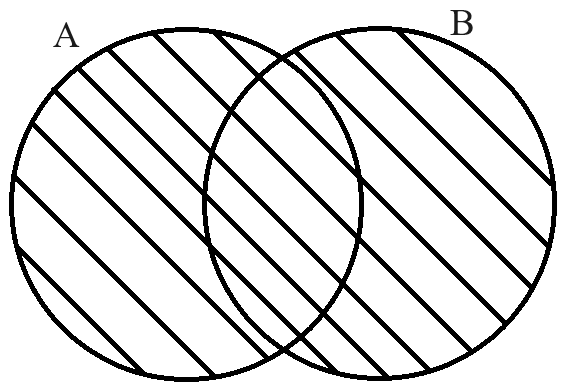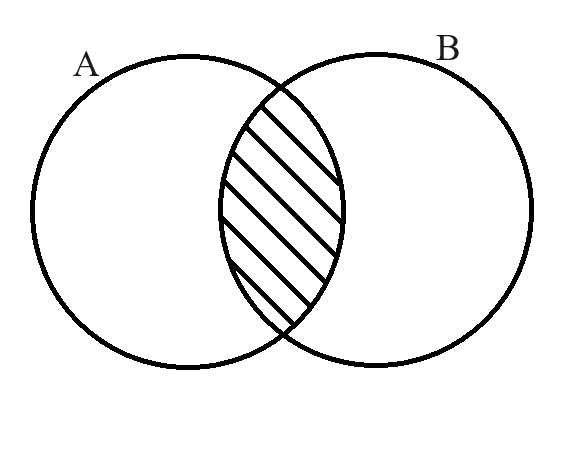Set
A set is a collection of objects. Each such objects are known as set elements.
E.g.: A set of vowels represented as:
A={a,e,i,o,u}
E.g.: A set of positive integers represented as:
A={0,1,2,3,...}
Set Notation
There are two kinds of set notations:
- Tabular method
- Set builder method
Tabular method
When the set is written with the actual data of elements, the form is said to be tabular.
E.g.: A set of positive integers:
A={0,1,2,3,...}
Set builder method
When the set is written in a generalized way, which denotes all available set elements within it, the form is said to be set builder.
E.g.: A set of positive integers:
A={x∣x≥0,x∈Z}={x∣x∈Z+}
E.g. A set of numbers divisible by 5:
A={x∣x MOD 5=0,x∈Z+}
Example 1: Write a set of letters of the word GOOGLE in both set builder and tabular form.
In tabular form:
A={G,O,L,E}
In set builder form:
A={x∣x∈A}={x∣x∈{G,O,L,E}}
Example 2: Write the set B={x∣x∈Z+,z≤9} in tabular form.
In tabular form:
B={0,1,2,3...9}
Subset
Let A and B be two sets. If every element of A is also an element of B, then A is a subset of B, and is written as A⊆B.
E.g.: Consider the following two sets A and B:
A={2,3,4}
B={1,2,3,4}
Since, all elements of A are in B, therefore A⊆B.
A set is also its own subset.
Power Set
Let A be a set containing n elements. The set of all subsets of A is called the power set of A. It consists of 2n elements. It power set of set A is denoted as:
P(A)
E.g.: Considering the set A={a,b,c}, then its powerset will be:
P(A)={{a},{b},{c},{a,b},{b,c},{a,c},{a,b,c},{ϕ}}
Null set ϕ is a subset of every set.
The following relations between numbers always hold true:
N⊆Z⊆R
where,
- N: natural numbers
- Z: integer numbers
- R: real numbers
Compliment of a Set
Let A and B be two sets. The set consisting of all elements of B, which are not in A, is called compliment of B, and is denoted as B−A.
Considering the following sets as an example:
B={5,9,8,12,15}
A={9,8,11,15}
Then, the compliment of B would be:
B−A={5,12}
Basic Operations on Sets
Following are the operations on sets:
- Union
- Intersection
- Symmetric difference
Union
Let A and B be two sets. The set consists of all elements of A or B or both, is called the union of A and B. It is written as A∪B.
Figure 1: Venn diagram for A∪B:

E.g.: Considering two sets: B={5,9,8} and, A={1,5,9,3}. Their union would be:
A∪B={1,3,5,8,9}
Intersection
Let A and B be two sets. The set elements which are both in A and B defines the intersection of A and B. It is written as A∪B.
Figure 2: Venn diagram for A∩B:

E.g.: Considering two sets:
A={1,5,9,3}
B={5,9,8}
Then, A∩B={5,9}
Symmetric difference
Symmetric difference between two sets A and B is defined by the set of all elements that belong to A or B, but not to both. It is denoted by A⨁B.
Figure 3: Venn diagram for A⨁B:

E.g.: Considering A={1,5,9,3} and, B={5,9,8}. Then, A⨁B={1,3,8}
Example 3: If A={1,2,3,4}, and B={1,3,5,7,11}. Then prove that A⨁B=(A−B)∪(B−A).
LHS=A⨁B={2,4,5,7,11}
RHS=(A−B)∪(B−A)={2,4}∪{5,7,11}={2,4,5,7,11}
∴A⨁B=(A−B)∪(B−A)
∴LHS=RHS, hence proved.
Principle of Inclusion and Exclusion
Let us suppose there are two sets A and B, and they share elements between each other. If we want to find the total no. of elements in A and B, without repeating any common element, then the principle of inclusion and exclusion states the following:
∣A∪B∣=∣A∣+∣B∣−∣A∩B∣
The number of elements of A is added with all elements in B. The sum is then subtracted from the common elements in A and B, which was added twice.
Principle of inclusion and exclusion of three variables
Let the three sets be A, B, and C.
Then,
∣A∪B∪C∣=∣A∪(B∪C)∣=∣A∣+∣B∪C∣−∣A∩(B∪C)∣
By distributive law, we know that A∩(B∪C)=(A∩B)∪(A∩C). Therefore,
=∣A∣+∣B∣+∣C∣−∣B∩C∣−∣(A∩B)∪(A∩C)∣=∣A∣+∣B∣+∣C∣−∣B∩C∣−{∣A∩B∣+∣A∩C∣−∣A∩B∩A∩C∣}
Since, A∩A=A, therefore:
=∣A∣+∣B∣+∣C∣−∣B∩C∣−{∣A∩B∣+∣A∩C∣−∣A∩B∩C∣}=∣A∣+∣B∣+∣C∣−∣B∩C∣−∣A∩B∣−∣A∩C∣+∣A∩B∩C∣
Therefore,
(A∪B∪C)=∣A∣+∣B∣+∣C∣−∣A∩B∣−∣A∩C∣−∣B∩C∣+∣A∩B∩C∣
Practice questions
- Let U={x∣x∈Z+,x≤9}, A={1,3,5,7}, B={2,4,6}, and C={1,2,3,4}. Find:
- (a) A∩B and A∩C
- (b) A∪B and B∪C
- (c) Bˉ and Cˉ
- (d) A⨁B and B⨁C
- (e) (A∪C)−B, A∪B, (B⨁C)−A
- Using Venn diagram, show the following sets:
- (a) (A∪B)∩C
- (b) A−(B−C)
- (c) A∩(B⨁C)
- (d) A−(B∪C)
- (e) Aˉ∩(C−B)
- (f) Aˉ∩(B∩C)
- Answer the following questions:
- (a) If A={6,2,3}, find P(A).
- (b) What is ∣A∣ and ∣P(A)∣?
- Let U={x∣x∈Z+,x≤9}, A={1,2,4,6,8}, B={2,4,5}, C={x∣x∈Z+,x2≤9}, and D={7,8}. Compute the following:
- (a) A−B
- (b) B−A
- (c) Cˉ
- (d) B⨁C
- (e) C⨁D
- (f) A∪Bˉ
- (g) A∩(Cˉ∪D)
- In MIT, from a batch of 125 students, 100 students of Mathematics opt for one of the following languages:
PASCAL, FORTRAN, and C++. 45 students opt for PASCAL, 25 students opt for FORTRAN, 10 students opt for C++, 5 students opt for both PASCAL and FORTRAN, 20 students opt for both FORTRAN and C++, 7 students opt for PASCAL and C++. Answer the following questions:
- (a) How many students study all languages?
- (b) How many students study only
FORTRAN?
- (c) How many students do not study any of the languages?


